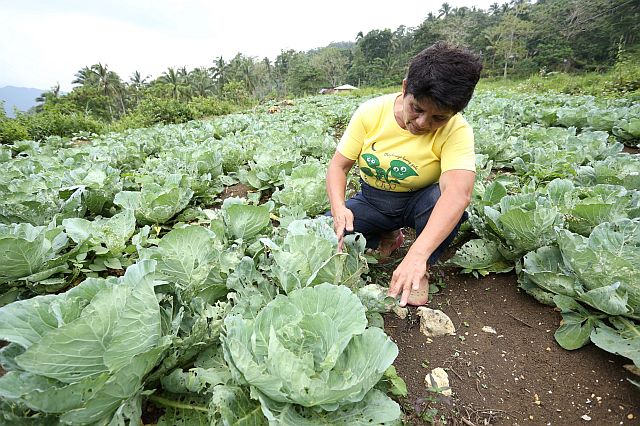El Niño’s effects can cause food price hikes next year

A farmer tends to her vegetable farm in Argao town in southern Cebu. CDN PHOTO/LITO TECSON
The strong El Niño occurring in the country today and the declining agricultural and fisheries production could cause an increase in the prices of food in the region early next year.
Melissa Guantero, National Economic and Development Authority (NEDA) Central Visayas supervising economic development specialist, warned the public and private sectors in Central Visayas about this scenario during a forum in Cebu City last week.
“The prices are stable as of first half of the year with average inflation rate at only 2.5 percent, but with the dry spell, we expect prices of food commodities to increase,” said Guantero.
She said NEDA expects a decline in agricultural production by yearend due to the dry spell.
She said the region will really need to put in place measures to see an increase in the production of agricultural products because this can also affect other aspects of the region’s economic growth and the country’s economy, considering that Central Visayas is one of the biggest and fastest growing economies in the country.
Science and Technology Secretary Mario Montejo earlier said that 79 provinces including those in Central Visayas will be affected by the strong El Niño weather system.
Montejo described the dry spell this year to be one of the worst since the 1997 El Niño.
Aside from the El Niño which is expected to affect the agricultural and fisheries sectors, Guantero also warned about the declining trend of this two sectors in the last five years.
She said these two sectors only account for a meager 6 percent in the gross regional domestic product (GRDP) last year.
She said this trend is something to worry about considering that the sector provides food security for the region.
“There is a bigger and more serious challenge confronting the region, and that is improving the productivity of its agricultural and fisheries sectors,” she said.
According to NEDA, in 2010, agriculture production was growing at 3.5 percent and 3.8 percent in 2011. The production, however, decreased to -1.5 percent in 2012, and only managed to grow by 0.2 percent in 2013. Last year it went down again at a negative 2.8 percent.
“The share of agriculture, which is the weakest among the three sectors (industrial, services), shrank from 8 percent share (of the GRDP) in 2011 to only 6 percent last year,” Guarnero said.
Guantero said Central Visayas is among the fastest growing regions in the country with a gross regional domestic product (GRDP) of 8.8 percent — third fastest after region 11 (GRDP of 9.4 percent) and region 3 (GRDP of 9 percent).
She said Central Visayas is one of the fastest growing economies in the country as the region supplies 7 percent of the total goods and services in the country.
The region’s growth, however, is fueled by six sectors which are manufacturing, outsourcing, tourism, construction, financial intermediation and retail trade.
Disclaimer: The comments uploaded on this site do not necessarily represent or reflect the views of management and owner of Cebudailynews. We reserve the right to exclude comments that we deem to be inconsistent with our editorial standards.
